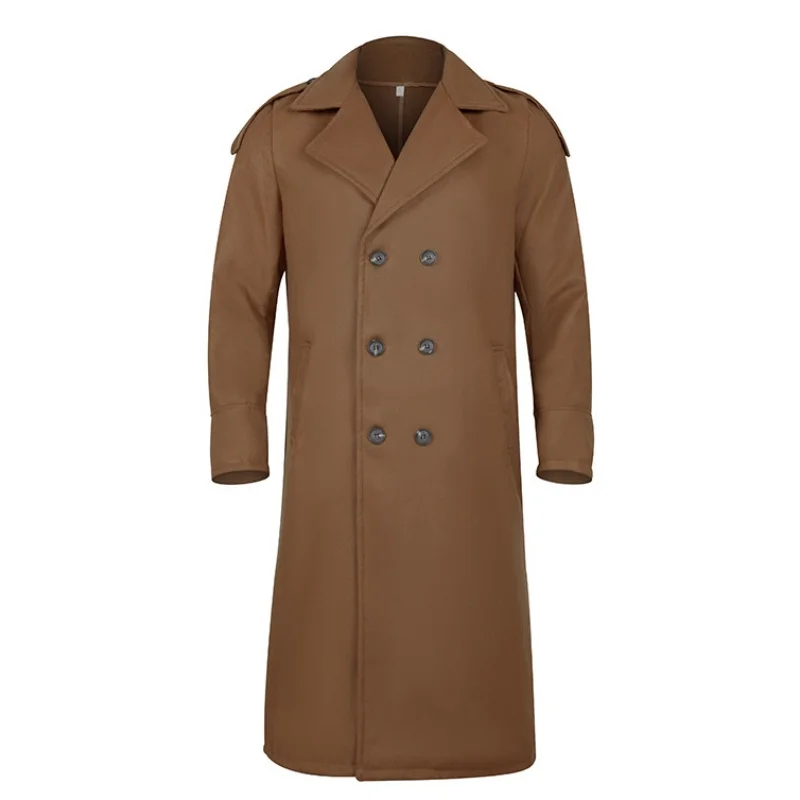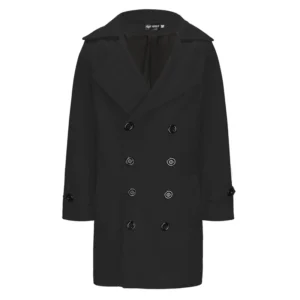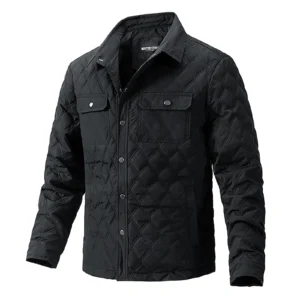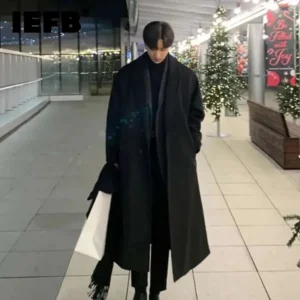Introduction to Double-Breasted Coats: A Timeless Classic in Men’s Fashion
The double-breasted coat stands as one of menswear’s most distinguished garments, characterized by its overlapping front panels and two parallel rows of buttons. This distinctive design creates a bold statement that has remained relevant through countless fashion cycles. Unlike many trendy items that come and go, the double-breasted coat has maintained its place in the gentleman’s wardrobe for generations.
What makes this coat truly special is how it transforms a man’s silhouette. The overlapping front panels create a V-shape that broadens the chest and shoulders while narrowing at the waist, producing a flattering effect for virtually any body type. This enhanced structure communicates confidence and sophistication without saying a word.
While traditionally associated with formal settings, the modern double-breasted coat has evolved to accommodate both business and casual environments. Today’s fashion-forward men pair these coats with everything from tailored suits to casual jeans, demonstrating the advantages double-breasted coats offer in terms of versatility and style impact.
Recent runway shows and street style photography reveal a significant resurgence of interest in double-breasted designs. This renewed appreciation stems from modern men seeking garments with substance and heritage in an increasingly disposable fashion landscape. The double-breasted coat answers this call by offering timeless appeal with contemporary relevance.
For those looking to make a confident style statement, our collection of men’s double-breasted overcoats provides numerous options that balance classic elegance with modern sensibility.
The Rich Heritage of Double-Breasted Coats
The story of the double-breasted coat begins at sea, where function preceded fashion. Naval uniforms of the 19th century featured double-breasted designs that provided extra protection against harsh maritime elements. The original pea coats worn by sailors featured shorter lengths and were crafted from heavy wool to withstand cold ocean winds. This practical overlap created an effective barrier against the elements, demonstrating how utility often births enduring style.
As civilian fashion began adopting military influences, the double-breasted design transitioned from shipdecks to city streets. By the early 20th century, the style had been embraced by gentlemen seeking both warmth and distinction in their outerwear. The transformation was complete – what began as practical uniform had become a style statement.
The 1920s and 1930s represented the golden age of the double-breasted coat. Style icons like the Duke of Windsor popularized the silhouette, wearing it with a casual elegance that influenced men worldwide. Hollywood cinema further cemented its appeal, with film stars projecting power and sophistication through their impeccably tailored double-breasted garments.
Following World War II, the coat experienced fluctuating popularity as fashion became more casual. However, the 1980s brought a dramatic revival during the “power dressing” era. Wall Street executives and business leaders embraced the authoritative presence that double-breasted suits and coats conveyed, often featuring exaggerated shoulders and wider lapels that emphasized dominance.
Today’s interpretations reflect a more balanced approach, retaining the coat’s inherent elegance while adapting to contemporary sensibilities. Modern tailoring has slimmed the silhouette without sacrificing its distinctive character, making the double-breasted coat more accessible to a wider audience.
Understanding the differences between double-breasted and single-breasted styles helps appreciate how this garment has evolved while maintaining its essential appeal through changing fashion landscapes.
Defining Characteristics of Double-Breasted Coats
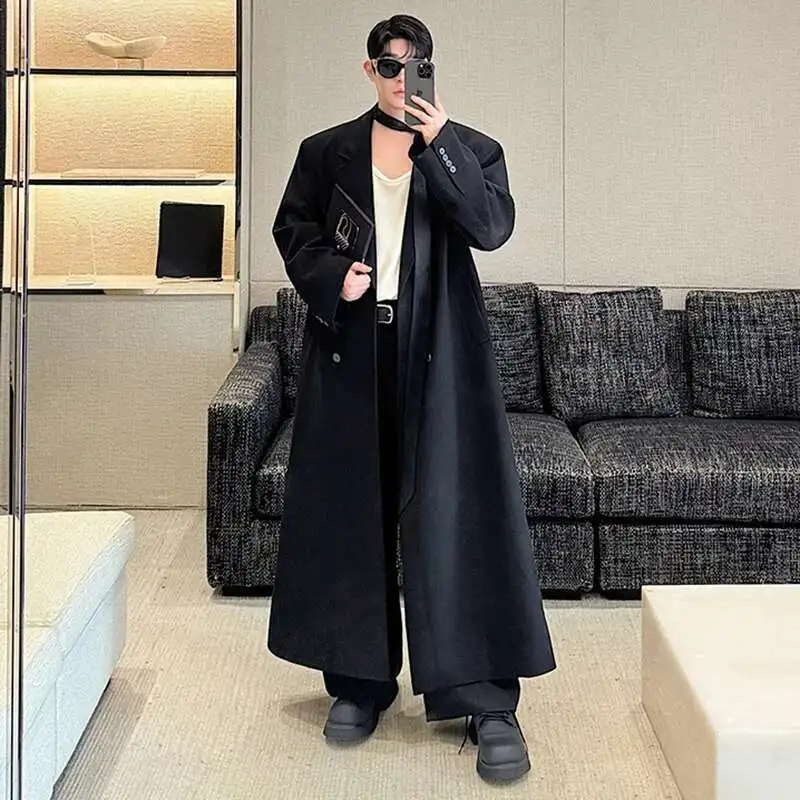
The double-breasted coat’s distinctive appearance comes from several key design elements that separate it from other outerwear options. Understanding these features helps appreciate the craftsmanship involved and ensures you can identify quality when making a purchase.
Essential Design Elements
Overlapping Front Panels: The defining feature of any double-breasted coat is its overlapping front, which creates a layered appearance and provides additional warmth.
Button Configuration: Most commonly found in “6×2” arrangement (six buttons with two functional), “4×2” (four buttons with two functional), or “6×1” (six buttons with one functional). The first number indicates total visible buttons, while the second indicates how many actually fasten.
Peak Lapels: Though some designs feature notch lapels, peak lapels pointing upward and outward are the traditional and most common choice, lending the coat an air of formality and elegance.
Gorge Line: The seam where the lapel meets the collar significantly impacts the coat’s appearance. Higher gorge lines create a more contemporary look, while lower ones appear more traditional.
Functional vs. Decorative Buttons: Quality coats often feature functional sleeve buttons, known as “surgeon’s cuffs,” which historically allowed doctors to roll up their sleeves while working.
Jigger/Anchor Button: This hidden internal button helps maintain the coat’s clean lines when fastened, preventing the overlapping fabric from shifting.
Double-breasted coats differ significantly from their single-breasted counterparts in both appearance and formality. The overlapping front creates a more substantial silhouette and generally conveys greater formality. While single-breasted designs tend to accommodate casual styling more readily, modern interpretations of double-breasted coats have become increasingly versatile.
It’s also important to distinguish between double-breasted coats, blazers, and suit jackets. Coats are typically longer (extending below the hip) and heavier, designed primarily for outerwear. Blazers and suit jackets are shorter, lighter garments intended for indoor wear as part of a complete outfit.
Understanding proper double-breasted coat buttoning rules is essential for wearing these garments correctly. Unlike single-breasted coats, which can be worn open or closed depending on the situation, double-breasted coats generally look best when buttoned while standing, as the overlapping design appears unbalanced when left unfastened.
For those interested in exploring the full spectrum of available options, our definitive guide to double-breasted overcoat styles provides a comprehensive overview of variations and their distinctive characteristics.
Material Matters: Fabrics and Construction
The fabric selection for a double-breasted coat significantly influences its appearance, performance, and longevity. Premium materials not only enhance comfort and durability but also affect how the coat drapes on your body and retains its shape over time.
Premium Fabric Options
Wool Varieties:
– Pure Wool: The classic choice, offering excellent insulation and natural water resistance. Higher quality wools feature finer fibers that prevent itchiness while maintaining durability.
– Merino Wool: Exceptionally soft with superior temperature regulation, ideal for dress coats that need to feel luxurious against finer garments.
– Lambswool: Soft yet durable, with excellent insulation properties and a slightly more casual appearance than merino.
Cashmere:
– The ultimate luxury option, offering unparalleled softness and up to three times more insulation than regular wool while being significantly lighter.
– Requires more careful maintenance but provides exceptional comfort and elegance.
Wool Blends:
– Wool/Cashmere: Combines durability with increased softness and warmth.
– Wool/Synthetic: Improves wrinkle resistance and potentially reduces cost, though pure natural fibers generally provide better insulation and breathability.
Alpaca:
– Rare but exceptional choice offering superior warmth with minimal weight and no lanolin (making it hypoallergenic).
Cotton and Technical Fabrics:
– Cotton gabardine and twill work well for transitional seasons when full wool is too warm.
– Modern technical fabrics sometimes blend with traditional materials to add performance features like water resistance.
Fabric Weight and Seasonality
Fabric weight, measured in ounces per square yard (oz/yd²), directly impacts a coat’s appropriate season:
– Lightweight (14-18 oz/yd²): Suitable for fall/spring or milder winter climates
– Medium (18-22 oz/yd²): Standard winter weight for most temperate regions
– Heavyweight (22+ oz/yd²): Designed for severe winter conditions
Quality Construction Elements
The difference between an average coat and an exceptional one often lies in its construction:
Canvas vs. Fused Construction: Superior coats use canvas interlining (either full or half) that conforms to your body over time, while fused coats use glued interlining that may bubble or separate with wear and cleaning.
Handwork Details: Hand-stitched elements like buttonholes, pick-stitching along lapels, and hand-attached linings indicate quality craftsmanship and attention to detail.
Lining Quality: Full silk or Bemberg (cupro) linings facilitate easy wearing over other garments and indicate premium construction. Quality coats feature “floating” linings attached at strategic points to allow movement.
Our collection of men’s wool coats showcases various fabric qualities and construction techniques, while our wool overcoat selection demonstrates how these materials perform in traditional silhouettes.
The Art of Fit: Finding Your Perfect Double-Breasted Coat
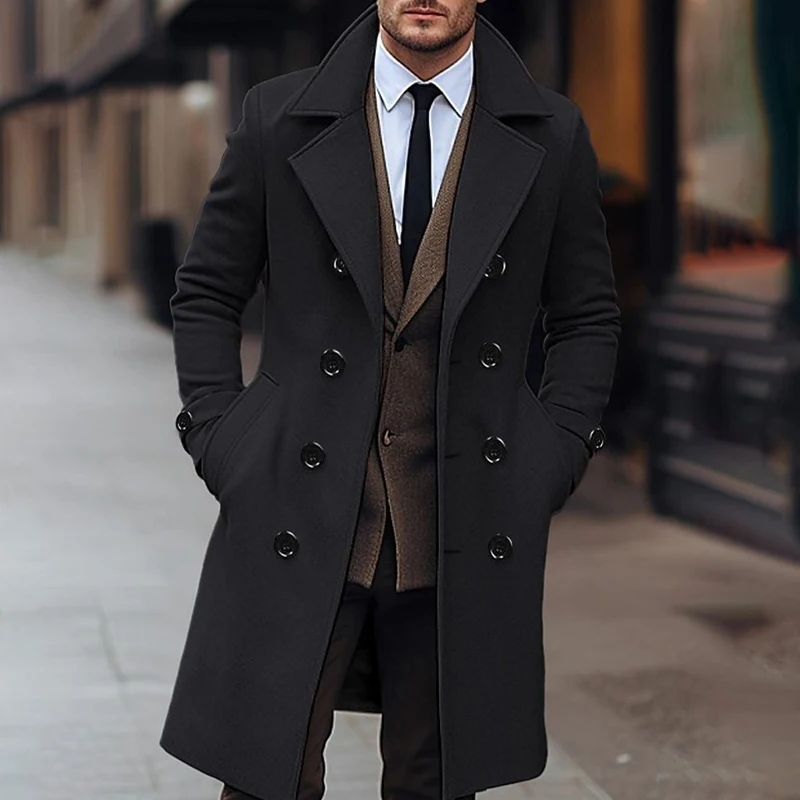
The distinguished appearance of a double-breasted coat depends significantly on proper fit. Unlike single-breasted alternatives that can sometimes be worn more casually, the double-breasted silhouette demands precision to maintain its elegant lines.
Critical Fit Points
Shoulders: The coat’s shoulder seams should align precisely with your natural shoulder ends. Too wide creates a sloppy appearance; too narrow restricts movement and creates pulling across the upper back. This is perhaps the most crucial fit point as shoulder alterations are extremely difficult.
Chest: When buttoned, the coat should close smoothly without strain across the buttons. There should be enough room to comfortably wear a suit or sweater underneath without restriction, but not so much that the coat appears boxy or oversized.
Lapel Lay: Properly fitted lapels lie flat against your chest without gaping or buckling. The “roll” of the lapel should be smooth and consistent, particularly important given the prominence of peak lapels on double-breasted designs.
Collar Fit: The collar should rest cleanly against your neck without standing away or bunching. When viewed from behind, it should follow the natural line where your neck meets your shoulders.
Sleeve Length: Ideally, sleeves should be long enough to cover your suit jacket sleeve while allowing approximately ¼-½ inch (0.6-1.3 cm) of shirt cuff to show when arms are relaxed at your sides.
Overall Length: Traditionally, overcoats extend to just above or at knee-level. This length provides adequate protection from elements while maintaining elegant proportions. Shorter men may opt for slightly shorter coats (mid-thigh) to maintain balanced proportions.
Button Stance: The position of the waist buttons significantly impacts the coat’s appearance. The ideal placement defines your waistline and creates the characteristic V-shaped silhouette.
Body-Type Specific Considerations
Taller Men: Seek coats with lower button stances and proportionally longer lengths to balance your height. Ensure sleeve length is adequate, as many standard sizes may run short.
Shorter Men: Choose slightly shorter coat lengths (above knee) and higher gorge lines to elongate your silhouette. Avoid overwhelming details like extremely wide lapels that can dominate your frame.
Athletic Builds: Ensure sufficient chest and shoulder room without excessive fabric through the waist. A well-defined waist suppression highlights your physique appropriately.
Larger Builds: Look for clean draping without pulling at closure points. Moderate shoulder structure provides balance, and properly positioned buttons create a flattering silhouette.
Our expert guide to double-breasted coat fit offers detailed guidance for achieving optimal fit, while information on choosing the right coat length helps ensure proportional elegance for your specific body type.
Styling Your Double-Breasted Coat: From Classic to Contemporary

The versatility of the double-breasted coat allows for numerous styling possibilities, from traditional formal ensembles to surprisingly contemporary casual looks. Understanding these styling options helps maximize the value and versatility of your investment.
Formal Styling Options
The double-breasted coat reaches its full potential when paired with formal attire:
Business Suits: The coat’s structured silhouette complements the clean lines of a well-tailored suit. Navy, charcoal, or camel coats pair beautifully with most business suit colors.
Complementary Collar Styles: Spread collars and semi-spread collars on dress shirts provide the necessary space to accommodate the wider lapels of a double-breasted coat.
Tie Selection: Ties with some substance (thicker silks or wools) stand up well to the bold presence of double-breasted lapels. Wider lapels generally pair best with ties of moderate width.
Formal Occasions: Double-breasted overcoats are particularly appropriate for business settings, evening events, and formal gatherings where sophistication is paramount.
Smart-Casual Interpretations
Modern styling has expanded the versatility of double-breasted coats:
Fine Knitwear Pairings: Turtlenecks and merino sweaters create a sophisticated yet relaxed appearance beneath a double-breasted coat, perfect for evening dinners or cultural events.
Trouser Options: While dress trousers create a cohesive smart look, premium dark denim provides an effective high-low contrast that feels contemporary while respecting the coat’s inherent elegance.
Footwear Coordination: Chelsea boots, dress boots, and quality leather loafers complement the refined nature of double-breasted coats in smart-casual contexts.
Balanced Ensembles: The key to successful smart-casual styling lies in balancing the coat’s formality with more relaxed pieces that still maintain quality and structure.
Modern Casual Styling
Contemporary approaches have revolutionized how double-breasted coats can be worn:
Layering Techniques: Experiment with lightweight sweaters, hoodies in muted colors, or even sweatshirts under a more relaxed double-breasted coat for an updated take.
Unexpected Combinations: Quality t-shirts, clean sneakers, and even tailored joggers can work with certain double-breasted coat styles (particularly pea coats and more casual wool options).
Relaxing the Silhouette: Leaving the coat unbuttoned creates a more casual appearance, though this works better with shorter double-breasted styles like pea coats rather than formal overcoats.
Button Etiquette
Proper buttoning maintains the coat’s intended silhouette:
- Traditional rules dictate keeping the coat buttoned when standing (unlike single-breasted coats which can be worn open).
- For 6×2 configurations, fasten only the middle row of buttons.
- For 4×2 configurations, fasten the lower row.
- For 6×1 configurations, use the single functional button.
Accessorizing Effectively
The right accessories enhance the double-breasted coat’s impact:
- Scarves: Both solid colors and patterns work well, with larger wool scarves for winter and lighter silk options for transitional seasons.
- Gloves: Leather gloves in coordinating colors (black, brown, or tan depending on coat color) complete a polished look.
- Pocket Squares: When wearing the coat with tailored clothing, a subtle pocket square adds a refined touch of personality.
- Hat Pairings: Fedoras and other structured hats complement the formal nature of longer double-breasted coats, while watch caps work with more casual pea coat styles.
For additional styling inspiration, explore our comprehensive styling guide and learn about mastering formal presentations with these distinguished garments.
Variations in Style: Exploring Double-Breasted Coat Designs
The double-breasted coat category encompasses numerous variations, each with distinct heritage and styling implications. Understanding these differences helps you select the perfect coat for your needs and preferences.
Length Variations
Short Coats (Pea Coats & Reefer Jackets):
– Typically end at hip level or slightly below
– Maritime heritage creates a more casual, rugged appeal
– Perfect for everyday wear and less formal settings
– Practical for active lifestyles and situations requiring greater mobility
Mid-Length Coats:
– Fall to just above or at knee-level
– Most versatile length, appropriate for business and formal occasions
– Balanced proportions suit most body types
– Provide good protection while maintaining ease of movement
Long Coats:
– Extend below the knee, sometimes to mid-calf
– Maximum formality and winter protection
– Create a dramatic silhouette with substantial presence
– Particularly flattering for taller men
Our men’s double-breasted pea coat collection showcases shorter variations, while our long overcoat selection features more formal extended lengths.
Silhouette Variations
Traditional Structured Shoulders:
– Defined shoulder line with padding
– Suppressed waist creating a dramatic V-shape
– Creates an authoritative, formal appearance
– Enhances shoulder width for balanced proportions
Relaxed Contemporary Cuts:
– Softer shoulders with minimal padding
– Less dramatic waist suppression
– More comfortable for casual wear
– Aligns with current trends toward relaxed tailoring
Modern Slim vs. Classic Full:
– Slim interpretations feature narrower sleeves and closer body fit
– Classic fuller cuts allow easier layering and create a more traditional drape
– Choice depends on both body type and intended styling
Design Details That Create Distinctive Looks
Lapel Variations:
– Width: Wider lapels (4+ inches) create classic drama, while narrower lapels appear more contemporary
– Gorge height: Higher gorge positions look modern, lower positions traditional
– Peak vs. notch: Peak lapels create formality, notch lapels appear slightly more casual
Button Considerations:
– Larger buttons create bold statements appropriate for casual styles like pea coats
– Smaller, covered buttons convey elegance suited to formal overcoats
– Button material affects both appearance and durability (horn, corozo, metal)
Pocket Styles:
– Flap pockets offer traditional styling with practical weather protection
– Patch pockets add casual character appropriate for less formal coats
– Jetted pockets create the cleanest, most formal appearance
Back Details:
– Center vents increase mobility but appear less formal
– Side vents balance movement with clean lines
– Belted backs add distinctive character to certain styles
Color and Pattern Options
Classic Solids:
– Navy: Maximum versatility with both formal and casual attire
– Charcoal: Professional and understated elegance
– Camel: Bold yet sophisticated statement piece that pairs well with business and casual wear
Statement Colors:
– Burgundy, forest green, and deep plum offer distinctive alternatives while maintaining sophistication
– Best as second or third coats after securing classic colors
Traditional Patterns:
– Herringbone: Subtle texture that maintains versatility
– Houndstooth: More distinctive pattern with traditional heritage
– Check patterns: Range from subtle glen plaids to bolder window panes
Assessing Quality: What Makes a Superior Double-Breasted Coat
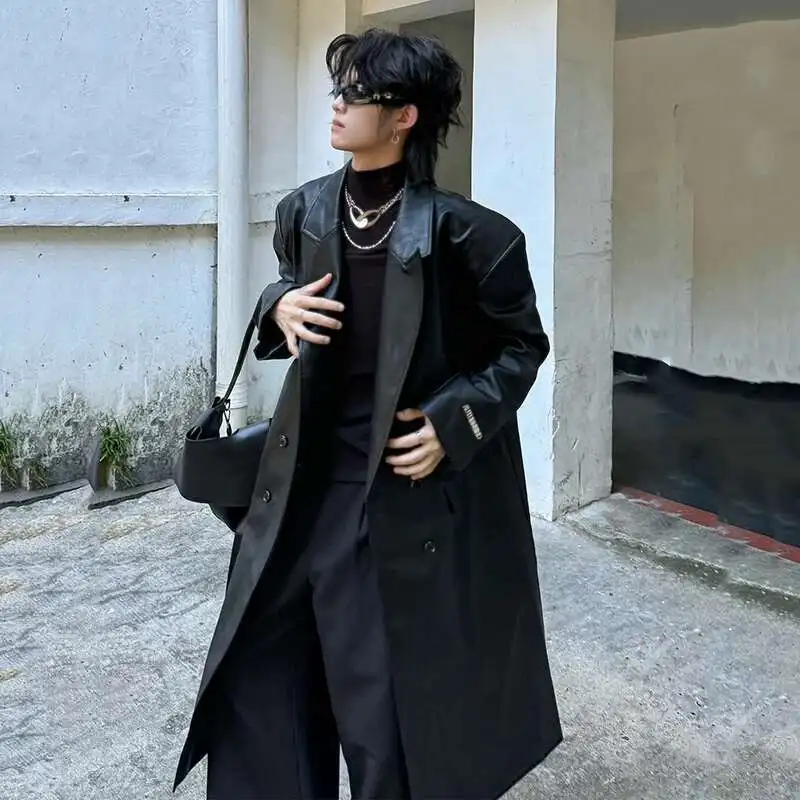
Identifying quality in double-breasted coats requires attention to several key indicators that separate exceptional garments from average ones. These distinctions justify price differences and predict long-term satisfaction with your investment.
Fabric Quality Indicators
Fiber Content and Optimal Blends:
– Pure wools with higher “Super” numbers (Super 120s and above) indicate finer fibers
– Cashmere percentage in blends (typically 10-20%) adds softness without compromising durability
– Natural fibers generally provide better temperature regulation and aging characteristics than synthetics
Fabric Density and Weight:
– Hold fabric to light – tightly woven cloths with minimal light penetration generally offer better insulation and durability
– Appropriate weight for intended use (14-22+ oz/yd²) ensures proper drape and warmth
– Heavier fabrics typically last longer but require proper support from internal construction
Hand Feel and Drape Evaluation:
– Quality fabrics feel smooth and substantial without stiffness
– Good recovery when crushed in hand indicates natural resilience
– Even drape without twisting or sagging suggests proper weaving and finishing
Construction Hallmarks of Quality
Seam Finishing and Reinforcement:
– Examine seam allowances (visible on unlined sections or inside pockets) – neatly finished edges prevent fraying
– Reinforced stress points at pocket openings and vent tops indicate durability-focused construction
– Consistent, even stitches with appropriate tension throughout
Buttonhole Quality:
– Hand-stitched buttonholes feature slightly irregular but dense stitching with gimp cord reinforcement
– Quality machine buttonholes show tight, consistent stitching without fraying
– Clean, precise cuts without loose threads
Button Attachment:
– Properly shanked buttons sit slightly above fabric surface, allowing fabric to fold properly when buttoned
– Secure attachment with reinforcement threads or backing buttons on heavier fabrics
– Quality materials like horn, mother-of-pearl, corozo, or high-grade synthetics that resist cracking
Lining Quality:
– Smooth, natural-fiber linings (Bemberg/cupro or silk) facilitate easy wearing and regulate temperature
– “Floating” construction attached at strategic points allows movement without binding
– Matched patterns and clean finishing at lining seams
Canvas vs. Fused Construction:
– Superior coats use canvas interlining (either full or half) that molds to your body over time
– Pinch test: gently pinch fabric between front panels – if layers separate slightly and feel distinct, likely canvas construction
– Fused coats use glued interlining that may bubble or separate with wear and cleaning
Design Considerations That Indicate Quality
Pattern Matching:
– Patterns (checks, stripes, herringbone) that align across seams, particularly at center back and pockets
– Symmetrical pattern placement on visible areas like lapels and front panels
– Directional patterns that follow body contours appropriately
Symmetry and Balance:
– Even lapels with identical shapes and rolls on both sides
– Balanced button spacing and alignment
– Even hem that hangs parallel to floor when worn
Three-Dimensional Lapel Roll:
– Quality lapels have a gentle roll rather than lying completely flat
– Created through proper canvassing and hand-padding in premium garments
– Contributes significantly to the coat’s overall aesthetic
Our collection of men’s cashmere overcoats exemplifies these quality indicators in their construction and materials.
Care and Maintenance: Preserving Your Investment
A quality double-breasted coat represents a significant investment that can provide decades of service when properly maintained. Implementing appropriate care routines preserves both appearance and structural integrity throughout its lifespan.
Routine Care Practices
Proper Brushing Techniques:
– Use a soft-bristled clothes brush to remove surface dirt and debris after each wearing
– Brush in downward strokes following the fabric’s natural direction
– Pay special attention to collar, cuffs, and front panels which accumulate the most soil
Appropriate Hanging Methods:
– Use wide, shaped wooden hangers that support shoulders without stretching
– Allow adequate space in closet to prevent crushing and creasing
– Never hang on wire or thin plastic hangers which create pressure points
Rotation Practices:
– Avoid wearing the same coat consecutive days if possible
– Allow 24-48 hours between wearings for wool fibers to recover and moisture to evaporate
– Multiple coats in rotation significantly extend each garment’s lifespan
Spot Cleaning:
– Address spills immediately by blotting (never rubbing) with clean cloth
– For water-based spills on wool, allow to dry then brush gently
– For persistent stains, consult professional cleaners rather than attempting home remedies
Seasonal Storage Protocols
Cleaning Before Storage:
– Always clean before extended storage to prevent moth attraction and stain setting
– Ensure coat is completely dry before storing to prevent mildew
– Follow fiber-specific cleaning recommendations (dry clean wool and cashmere, etc.)
Proper Garment Bags:
– Use breathable cotton garment bags rather than plastic which traps moisture
– Ensure bag is long enough to accommodate entire coat without folding
– Leave small opening at bottom for air circulation
Natural Moth Prevention:
– Cedar blocks or chips (refresh scent periodically with light sanding)
– Lavender sachets (replace every few months as scent fades)
– Avoid mothballs which contain harmful chemicals and leave persistent odors
Ideal Storage Conditions:
– Cool, dry, dark environment minimizes fabric stress
– Avoid attics, basements, and direct sunlight
– Maintain consistent temperature and humidity when possible
Professional Maintenance
Dry Cleaning Considerations:
– Limit dry cleaning to 1-2 times per season as chemicals can degrade natural fibers
– Only clean when visibly soiled or before storage
– Find cleaners specializing in fine outerwear rather than general services
Finding Qualified Specialists:
– Seek cleaners experienced with premium outerwear
– Ask about their specific processes for wool or cashmere coats
– Consider specialists affiliated with high-end department stores or menswear retailers
Communicating Special Requirements:
– Inform cleaners about fabric content (especially cashmere blends)
– Point out any areas of concern or previous repairs
– Request minimum pressing to maintain lapel roll and natural drape
Common Issues and Solutions
Managing Fabric Wear:
– Reinforce areas showing early signs of wear (elbow patches, pocket edges)
– Address pilling by carefully removing with sweater stone or fabric shaver
– Rotate coat to distribute wear patterns
Button Maintenance:
– Tighten loose buttons before they detach
– Replace missing buttons promptly to maintain appearance
– Keep spare buttons (often provided with quality coats) for future needs
Addressing Minor Damage:
– Small tears or seam separations should be repaired immediately before expanding
– Professional reweaving can address small holes in valuable garments
– Consider internal reinforcement for weakened areas
For those with specialty outerwear like leather double-breasted coats, our guide to leather coat care and maintenance provides material-specific recommendations.
Mens Double Breasted Pea Coat, Mens Wool Blend Coat, Mens Wool Pea Coat
Price range: $136.84 through $157.36 Select options This product has multiple variants. The options may be chosen on the product pageMens Cashmere Overcoat, Mens Hooded Winter Coat, Mens Wool Blend Coat
Price range: $128.72 through $139.68 Select options This product has multiple variants. The options may be chosen on the product pageMens Black Overcoat, Mens Black Wool Coat, Mens Wool Overcoat
$339.18 Select options This product has multiple variants. The options may be chosen on the product pageMens Double Breasted Pea Coat, Mens Hooded Winter Coat, Mens Quilted Coat
Price range: $81.00 through $108.48 Select options This product has multiple variants. The options may be chosen on the product pageMens Grey Overcoat, Mens Wool Blend Coat, Mens Wool Overcoat
$201.28 Select options This product has multiple variants. The options may be chosen on the product pageMens Herringbone Coat, Mens Long Overcoat, Mens Wool Overcoat
Price range: $197.16 through $203.69 Select options This product has multiple variants. The options may be chosen on the product page
Purchasing Guide: Finding the Perfect Double-Breasted Coat
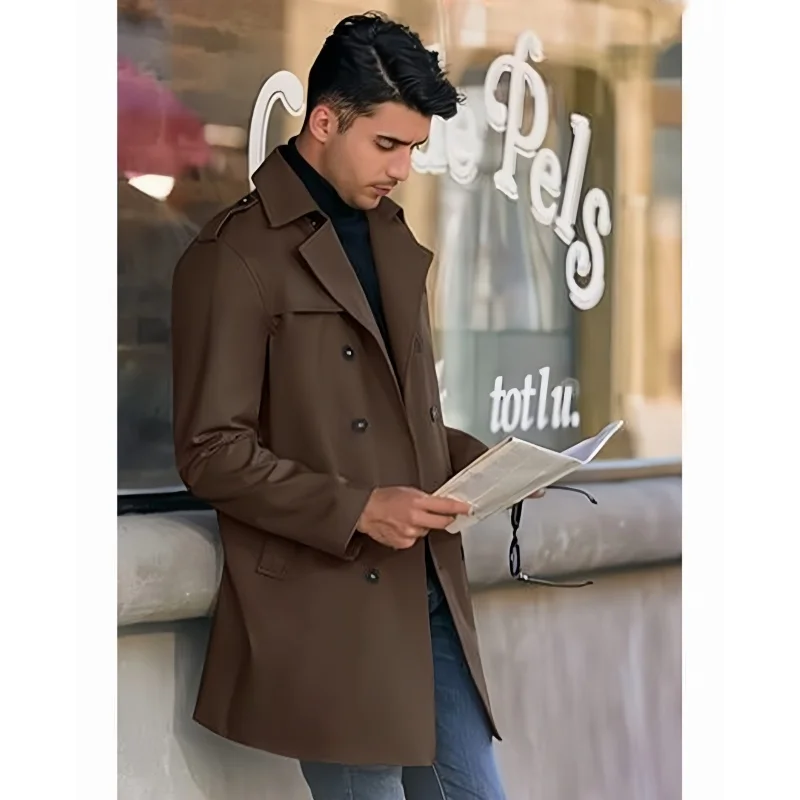
Finding the ideal double-breasted coat requires understanding what different price points offer and where to shop for the best value. This knowledge helps you make an informed decision that balances budget with quality expectations.
Considerations for Different Price Ranges
Entry-Level Options ($150-400):
– Typically feature wool blends rather than pure wool
– Often use fused construction rather than canvas
– May have synthetic linings and simpler finishing details
– Best for occasional wear or testing if the style works for you
Mid-Range Investments ($400-900):
– Better fabric quality with higher wool content or wool/cashmere blends
– Half-canvas construction in better examples
– Improved linings and more attention to detail
– Represent good value for regular but not daily wearers
Premium and Luxury Offerings ($900+):
– Pure wool, cashmere, or premium blends from renowned mills
– Full canvas construction with extensive handwork
– Exceptional finishing details and premium components
– Built to last for decades with proper care
Shopping Venues and Their Advantages
Department Stores and Specialty Menswear Retailers:
– Opportunity to try multiple sizes and styles in person
– Sales staff may provide fit and styling advice
– Seasonal sales can offer significant value
– Easy returns and alterations often available
Online Retailers:
– Wider selection than typically available locally
– Detailed product descriptions and measurements
– Reviews from previous purchasers provide additional insight
– Competitive pricing with frequent promotions
– Look for generous return policies and clear sizing guides
Vintage and Second-Hand Options:
– Often feature superior materials and construction from earlier eras
– Significantly lower prices for comparable quality
– Unique details and styles not found in contemporary offerings
– Requires patience and knowledge to find good examples in proper condition
The Spectrum of Customization
Ready-to-Wear Convenience:
– Immediate availability
– Predetermined styling and proportions
– Most economical option
– Best for standard body types
Made-to-Measure Opportunities:
– Based on existing patterns adjusted to your measurements
– Some fabric and styling customization options
– Moderate price premium over ready-to-wear
– Delivery typically takes 4-8 weeks
Full Bespoke Commissions:
– Created from scratch for your specific measurements
– Complete customization of design, fabric, and details
– Highest price point reflecting extensive handwork
– Multiple fittings ensure perfect results
– Delivery typically takes 8-12 weeks or longer
Evaluating Value Beyond Price
Cost-Per-Wear Calculation:
– A $1,000 coat worn 30 times yearly for 10 years equals approximately $3.33 per wear
– Higher initial investment often results in lower long-term cost
– Consider how frequently you’ll wear the coat in your climate
Investment Perspective:
– Quality coats maintain appearance and functionality for decades
– Classic styles resist fashion obsolescence
– Superior materials age gracefully with proper care
Balancing Trend with Longevity:
– Choose classic proportions with subtle contemporary details
– Avoid extreme styling that will quickly date the garment
– Navy, charcoal, and camel colors offer maximum versatility and staying power
For comprehensive guidance on when and where to wear your double-breasted coat, explore our definitive wearing guide that covers various occasions and settings.
How to Build a Versatile Outerwear Collection
A well-planned outerwear collection provides options for various settings and weather conditions, with the double-breasted coat serving as an elegant cornerstone. Strategic selection ensures maximum versatility with minimal redundancy.
The double-breasted coat typically occupies the formal end of an outerwear collection, making it ideal for business settings, evening events, and situations requiring a sophisticated presence. This positioning guides your additional coat purchases toward complementary rather than competing styles.
Complementary coat styles that balance a collection include:
– A single-breasted topcoat for streamlined business casual wear
– A technical raincoat or trench for inclement weather
– A casual field jacket or bomber for weekend activities
– A heavy parka for extreme weather conditions
Strategic color selection maximizes versatility across your collection. Consider this approach:
1. Begin with a navy or charcoal double-breasted coat (maximum versatility)
2. Add complementary styles in contrasting colors (camel topcoat, olive field jacket)
3. Ensure each piece pairs well with the majority of your wardrobe
When building a collection over time, prioritize versatility and quality in your initial purchases. A well-made double-breasted coat in navy or charcoal provides immediate elegance for business and formal settings. As budget allows, add pieces that address specific needs or seasonal requirements not covered by existing items.
The Metro Cloak collection offers classic double-breasted coat designs that serve as excellent foundation pieces around which to build your complete outerwear wardrobe.
Is a Double-Breasted Coat Right for You?
Despite their unquestionable elegance, double-breasted coats raise common questions about their suitability for different individuals and lifestyles. Addressing these concerns helps determine if this style aligns with your specific needs.
“Are double-breasted coats still relevant today?”
Absolutely. While their popularity fluctuates, double-breasted coats have never truly disappeared from the fashion landscape. Current trends show renewed interest in this classic silhouette, with designers offering both traditional and updated interpretations. Their structured elegance provides a distinctive alternative to ubiquitous casual outerwear.
“Can shorter men wear double-breasted styles?”
Yes, with appropriate adjustments. Shorter men should seek coats with:
– Proportionally shorter length (above knee)
– Higher button stance to elongate the leg line
– Moderate lapel width that doesn’t overwhelm
– Subtle vertical patterns that create height
These modifications maintain the double-breasted style’s elegance while complementing a shorter frame.
“Are they too formal for everyday wear?”
While traditionally formal, modern styling has expanded their versatility. For everyday wear, consider:
– More casual variations like pea coats
– Relaxed styling with knitwear instead of suits
– Less structured versions with softer shoulders
– Textured fabrics that feel less formal
“Do double-breasted coats work for larger body types?”
When properly fitted, double-breasted coats can flatter larger frames by:
– Creating vertical lines that elongate the silhouette
– Providing structure that defines the body shape
– Offering proper drape that skims rather than clings
The key is avoiding excessive fabric while ensuring proper closure without strain.
Double-breasted coats best suit those who appreciate classic style with architectural presence. They align well with professional environments and social occasions where a distinguished appearance matters. While requiring slightly more confidence to wear than single-breasted alternatives, they reward the wearer with unmistakable elegance and presence.
Your lifestyle should inform your choice – those in formal business environments or who regularly attend dressy social functions will find more opportunities to wear this style than those with primarily casual lifestyles. However, modern styling approaches have expanded the double-breasted coat’s versatility, making it increasingly adaptable to contemporary wardrobes.

